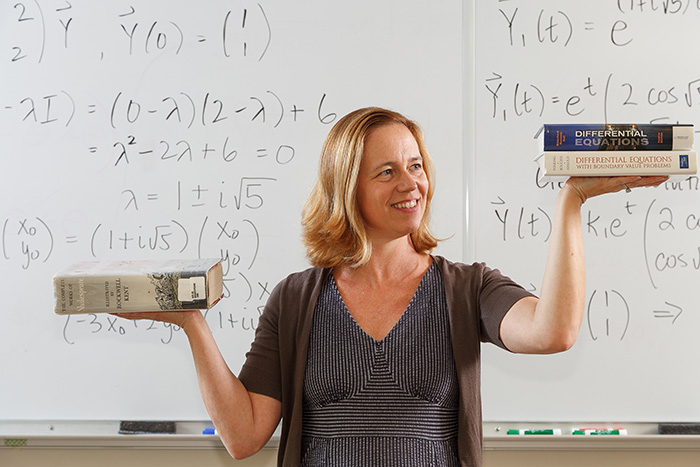What Light Through Yonder Protractor Breaks?

Photo by Carl Socolow '77.
Paper explores offbeat mathematical approaches to humanities, arts
by MaryAlice Bitts-Jackson
If Juliet had been coy or aggressive, would her star-crossed romance have fizzled, averting tragedy? It’s a question that literary scholars and social scientists might ponder for fun, but there’s another interesting perspective to consider—the mathematician’s.
A paper by Professor of Mathematics Lorelei Koss surveys mathematical models that explore the humanities and arts, and shines light on the artists, architects, writers and filmmakers who tap mathematical principles in their works. Published in the Journal of Mathematics and the Arts, “Differential Equations in Literature, Poetry and Film” helps make the humanities and arts more dynamic to math- and science-minded students, while bringing mathematical equations into more user-friendly territory for students of a literary or artistic bent.
The calculus of cannibalism
The idea came to Koss two years ago, while teaching a course on differential equations—those calculus-based formulas used to predict changes over time, such as the spread of an epidemic, or weather patterns. She asked her students to read, watch or study source material; identify a mathematical model that related to it; and then explain how.
“My overarching goal was to give the students a different lens to look at these subjects—to push their boundaries,” she says, “and they ran with it.” And so did she, plumbing journals and artists’ statements for examples of offbeat mathematical applications.
The examples range from the silly—models have tracked “Bieber fever” and literary vampirism as one might track a fast-spreading disease—to the substantive, as when architects use equations to ensure a bridge’s stability and to add symmetry to designs.
Koss also found writers and artists who use math to generate patterns. She read an article outlining the use of pursuit curves in a 1638 short story about swans carrying a man to the moon. She discovered a scholar who used equations to predict rates of growth of cannibal tribes, like those in a Melville work, and another who noted James Joyce’s use of the butterfly effect. Mathematics has been used to analyze the 12 labors of Hercules and to bring new shades of understanding to the Bible and the rise and fall of languages.
Koss’ students provided additional examples. Katie Ramire '14, a double major in math and Italian, located an article on the mathematics of Petrarch’s writings. Katherine Roy '15, a student-choreographer who double majored in physics and math, passed along an article about choreographic works informed by the mathematical chaos theory.
If romance, then love?
How does it work? In the case of Romeo and Juliet, outlined in an article by Steven Strogatz, we must appreciate the psychological underpinnings of the Bard’s lead characters to mathematically map out Romeo’s feelings at given points in time, with respect to Juliet’s responses. (If Juliet were coy, for example, Romeo might pursue her more aggressively.) Translating character traits and plot developments into mathematical functions, the reader-mathematicians could identify changes over time and calculate the likely outcome of their love affair.
Viewed in this light, literature and the arts become “playgrounds for mathematical explanations,” says former math major James Cousins ’14, who took Koss’ differential-equations class and recalls it vividly, two years down the road.
“It was really amazing, because all of a sudden, you're not watching ‘x’ increase and decrease; you're watching Romeo's affection for Juliet increase and decrease, and how that influences ‘y,’ ” he explains. “That really casts the mathematical principles in a more significant light, especially for someone who hasn't yet seen all that theorems and rules can accomplish in the real world … It made me think about how to apply mathematics to other disciplines too.”
Koss will bring these techniques back into the classroom when she teaches differential equations in the fall. And while stretching disciplinary boundaries for students, she’s enjoying a bit of scholarly adventure too. “I’ve been researching for many years, but there were aspects of this project that were entirely new to me, like the process of copyright permissions, for example,” she says. “As a mathematician, I never had to consider that before.”
Learn more
Published August 26, 2015